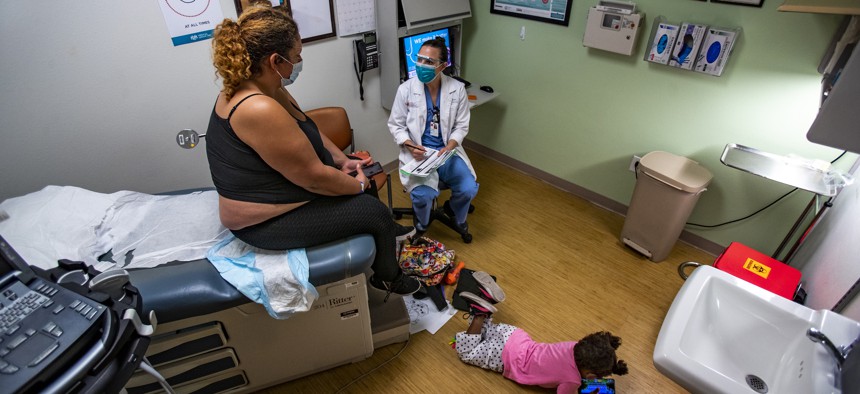Mortality rate for young women grew significantly during the pandemic, report says

Dr. Lisa Hofler, the clinical vice chair of the Department of Obstetrics and Gynecology at the University of New Mexico, discusses the procedure for getting a medication abortion with a patient in June 2022. Gina Ferazzi / Los Angeles Times via Getty Images
As the nation marks the one-year anniversary of the Dobbs decision, a new report finds an uptick in deaths among young women. Researchers worry the trend will worsen as more states limit access to reproductive health care.
Mortality rates among young women nationwide jumped nearly 40% between 2019 and 2021, according to a new report. The finding comes as the nation marks the one-year anniversary of the Supreme Court ruling that overturned Roe v. Wade.
The number of women of reproductive age who died from pregnancy-related issues, substance use and other conditions rose quickly during the pandemic, found The Commonwealth Fund, a nonprofit research group focused on health care issues. Last week, it published its annual Scorecard on State Health System Performance, which ranks states based on dozens of health care indicators, such as affordability, preventive care and racial disparities.
This year’s scorecard is the first iteration to take a comprehensive look at data surrounding reproductive and women’s health—a sign of the times, said David Radley, the report's lead author. Using data mostly from 2021, the scorecard aims to provide a baseline to help measure any impact the Dobbs decision, which left policies on abortion and other reproductive health care to the states, may have on women’s health moving forward.
“The Dobbs decision changes the types of health services that are available to women,” Radley said. “It makes it possible for those changes to be implemented on a state-by-state basis.”
Twelve of the 15 states that ranked lowest in the women’s health category have enacted restrictive abortion policies since last year’s ruling, prompting fears that maternal health gaps will widen. Many of the lowest-performing states, however, already had fewer maternal health care providers prior to the Supreme Court decision.
Louisiana, Mississippi and Tennessee, where state laws restrict abortions, had the highest rates of maternal mortality. Between 2019 and 2021, West Virginia saw the greatest increase in mortality rates among women aged 15 to 44, peaking at 238 deaths per 100,000 women. That’s nearly triple the rate of Hawaii, which saw the smallest increase in deaths for the demographic.
Many of those deaths could have been prevented by easier, more equitable access to comprehensive health care, the report concludes. Maternal mortality in the U.S. is nearly twice as high compared to other high-income countries. For women of color—especially Indigenous and Black women—those rates are even higher, and a shortage of maternal health care providers is a challenge across all states.
The difference in care state-by-state is stark. In Vermont, for example, only 11% of women who gave birth in 2021 didn’t have access to prenatal care, which is critical to the early identification of issues that could complicate pregnancy or birth. In Florida and Texas—where maternal death rates were higher than in most states—about 30% of women didn’t have access to prenatal care.
One of the most important steps states can take to ensure women get the care they need is to expand Medicaid and offer 12 months of postpartum coverage, Radley said.
Meanwhile, every state saw an increase in premature avoidable deaths, defined as deaths of people under 75 that could have been avoided or treated. That increase was largely driven by COVID deaths, said Radley, although deaths from overdoses and mass shootings also grew significantly, lowering the country’s overall life expectancy.
In 2021, the combined deaths from drug overdoses, alcohol and suicide claimed upwards of 200,000 lives—50,000 more than the pre-pandemic high in 2019. In that same timeframe, firearm-related deaths increased by about 23%.
These numbers not only underscore the behavioral health impacts of the pandemic, but also highlight the gaps in the country’s health care landscape, Radley said. “We need to do a better job of integrating behavioral health care services with primary care.”
Nationwide, more than half of adolescents and adults with mental illnesses reported not receiving treatment. That figure is even greater in some states. In South Carolina, for instance, nearly 80% of teens who experienced a major depressive episode said they didn’t receive any treatment, as did about 70% of adults in Hawaii.
Overall, the states that ranked best in the report were Massachusetts, Hawaii, New Hampshire, Rhode Island andVermont.
Four of those five states are in New England. While it’s difficult to nail down exactly why there’s a concentration in the Northeast, some clues lie in social factors, Radley said. For example, incomes in Northeastern states are typically higher than those in the South.
But policy decisions are also likely to play a role in the rankings, Radley added. Massachusetts, for instance, was an early leader in expanding insurance coverage to all residents.
The bottom five states in the rankings were Mississippi, West Virginia, Oklahoma, Texas and Arkansas. These states performed particularly poorly in categories including access and affordability of care, avoidable hospital use and women’s health.
Ultimately, the report underscores the dramatic and far-reaching effects of COVID-19 and the gaps in states’ medical systems, says Radley.
“Seeing the data in this way helps us understand the magnitude of the impact of the pandemic,” he said, “and the magnitude of the impact of decades of policy differences between states.”






